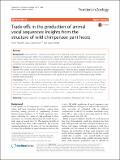Files in this item
Trade-offs in the production of animal vocal sequences : insights from the structure of wild chimpanzee pant hoots
Item metadata
| dc.contributor.author | Fedurek , Pawel | |
| dc.contributor.author | Zuberbuhler, Klaus | |
| dc.contributor.author | Semple, Stuart | |
| dc.date.accessioned | 2017-11-08T12:30:14Z | |
| dc.date.available | 2017-11-08T12:30:14Z | |
| dc.date.issued | 2017-11-06 | |
| dc.identifier | 251351184 | |
| dc.identifier | d526eccf-3493-4d8c-898f-1fc35d1618b5 | |
| dc.identifier | 85032899968 | |
| dc.identifier | 000414549500001 | |
| dc.identifier.citation | Fedurek , P , Zuberbuhler , K & Semple , S 2017 , ' Trade-offs in the production of animal vocal sequences : insights from the structure of wild chimpanzee pant hoots ' , Frontiers in Zoology , vol. 14 , no. 50 . https://doi.org/10.1186/s12983-017-0235-8 | en |
| dc.identifier.issn | 1742-9994 | |
| dc.identifier.other | ORCID: /0000-0001-8378-088X/work/64360727 | |
| dc.identifier.uri | https://hdl.handle.net/10023/12032 | |
| dc.description | The study was funded by Swiss National Science Foundation (310030_143359) and European Research Council project grants awarded to KZ (PRILANG 283871). | en |
| dc.description.abstract | Background Vocal sequences - utterances consisting of calls produced in close succession - are common phenomena in animal communication. While many studies have explored the adaptive benefits of producing such sequences, very little is known about how the costs and constraints involved in their production affect their form. Here, we investigated this issue in the chimpanzee (Pan troglodytes schweinfurthii) pant hoot, a long and structurally complex vocal sequence comprising four acoustically distinct phases – introduction, build-up, climax and let-down. Results We found that in each of these phases, and for the sequence as a whole, there was a negative relationship between the number of calls produced and their average duration. There was also a negative relationship between the total duration of some adjacent phases. Significant relationships between the fundamental frequency of calls and their number or duration were found for some phases of the sequence, but the direction of these relationships differed between particular phases. Conclusions These results indicate that there are trade-offs in terms of signal duration at two levels in pant-hoot production: between call number and duration, and between the relative durations of successive phases. These trade-offs are likely to reflect biomechanical constraints on vocal sequence production. Phase-specific trade-offs also appear to occur between fundamental frequency and call number or duration, potentially reflecting that different phases of the sequence are associated with distinct types of information, linked in different ways to call pitch. Overall, this study highlights the important role of costs and constraints in shaping the temporal and acoustic structure of animal vocal sequences. | |
| dc.format.extent | 2504892 | |
| dc.language.iso | eng | |
| dc.relation.ispartof | Frontiers in Zoology | en |
| dc.subject | Acoustic trade-offs | en |
| dc.subject | Call sequences | en |
| dc.subject | Chimpanzee | en |
| dc.subject | Compression | en |
| dc.subject | Menzerath’s law | en |
| dc.subject | Pant hoot | en |
| dc.subject | BF Psychology | en |
| dc.subject | QL Zoology | en |
| dc.subject | NDAS | en |
| dc.subject.lcc | BF | en |
| dc.subject.lcc | QL | en |
| dc.title | Trade-offs in the production of animal vocal sequences : insights from the structure of wild chimpanzee pant hoots | en |
| dc.type | Journal article | en |
| dc.contributor.institution | University of St Andrews. School of Psychology and Neuroscience | en |
| dc.contributor.institution | University of St Andrews. Institute of Behavioural and Neural Sciences | en |
| dc.contributor.institution | University of St Andrews. Centre for Social Learning & Cognitive Evolution | en |
| dc.identifier.doi | https://doi.org/10.1186/s12983-017-0235-8 | |
| dc.description.status | Peer reviewed | en |
This item appears in the following Collection(s)
Items in the St Andrews Research Repository are protected by copyright, with all rights reserved, unless otherwise indicated.

